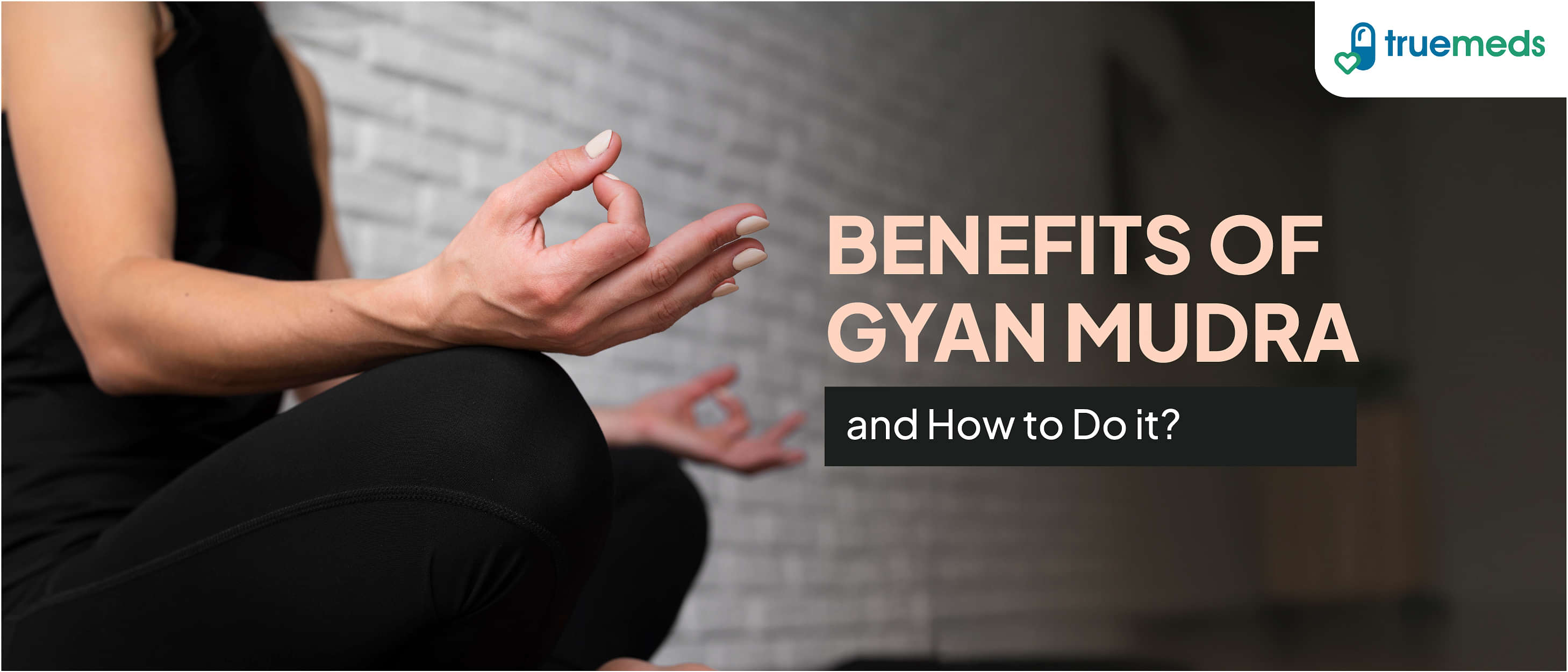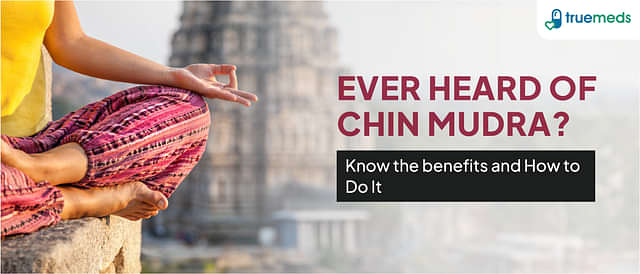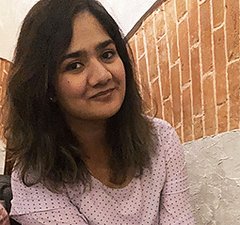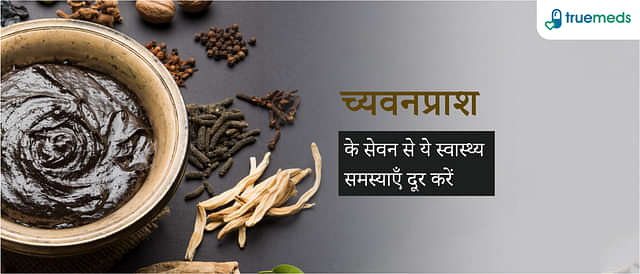Benefits of Gyan Mudra and How to Do It?
Last updated on : 19 Nov, 2025
Read time : 5 min
What is Gyan Mudra?
Gyan Mudra combines the Sanskrit words ‘Gyan’ (knowledge) and ‘Mudra’ (gesture) to form a hand posture symbolising the unity of individual and universal consciousness. Touching the thumb to the tip of the index finger creates a circle, representing completeness and balance. Traditionally used in seated meditation, it can also be incorporated into yoga poses, such as Dancer’s Pose or Extended Side Angle Pose. This mudra is widely practiced to help regulate the nervous system, improve focus, and promote mindfulness [3].
How to Do Gyan Mudra
Practising Gyan Mudra is simple and can be done almost anywhere! Here’s a step-by-step guide to help you start your practice:
- Sit Comfortably: Choose a seated posture such as Lotus (Padmasana) or Cross-Legged (Sukhasana) with a straightened but relaxed spine.
- Place Your Hands: Rest your hands on your knees or thighs, palms facing upward.
- Form the Mudra: Touch the tip of your thumb to the tip of your index finger, keeping the other three fingers relaxed and gently extended.
- Focus and Breathe: Close your eyes or soften your gaze and take slow, deep breaths.
- Hold the Position: Maintain the mudra for a few minutes, gradually increasing the duration as you become more comfortable.
Key Potential Benefits of Gyan Mudra
Gyan Mudra is a common and popular practice that may be beneficial for individuals seeking to enhance their mental clarity, emotional stability, and overall well-being. Here are some of the key potential benefits often associated with this mudra.
1. Potential for Enhanced Focus and Cognitive Clarity
Gyan Mudra is widely believed to stimulate neural pathways associated with concentration and clarity. One systematic review suggested that regular yoga and mudra practice, when combined with meditation, may support improvements in cognition and mood [1].
By encouraging stillness and breath control, this mudra may help reduce “mental clutter,” which can, in turn, support focus and memory—particularly helpful for students and working professionals.
2. Supporting Mental and Emotional Balance
Gyan Mudra promotes mental stability by fostering a state of calmness and clarity. Practising it may encourage mindfulness and calmness, helping to reduce distractions and support emotional balance. This mudra promotes mindfulness, making it easier to stay present and manage overwhelming thoughts. Consistent practice may lead to a greater sense of emotional balance and resilience in the face of stress.
3. Complementary Tool for Managing Anxiety
Gyan Mudra may help reduce anxiety by promoting relaxation and supporting the body’s natural calming response. Forming this mudra is believed to help soothe the nervous system, thereby easing feelings of stress and tension. Studies have explored the positive effect of Gyan Mudra on reducing psychological stress and anxiety levels in specific populations, such as students [2]. By engaging in this mudra during moments of anxiety, people can find a sense of grounding and peace. The act of forming Gyan Mudra can serve as a reminder to breathe deeply and reconnect with the present moment, which is essential in managing anxiety effectively.
Other Potential Benefits
Beyond supporting focus, mental stability, and anxiety management, Gyan Mudra is an integral part of yogic philosophy and practice, offering a range of additional benefits based on traditional belief [4]:
- Enhances Spiritual Awareness: This mudra is often associated with increased spiritual insight and self-awareness, helping individuals connect with their inner wisdom and intuition.
- May Improve Sleep Quality: By calming the mind and reducing anxiety, Gyan Mudra may promote better sleep, making it a helpful practice for those struggling with mild insomnia.
- Indirectly Supports Well-being: While Gyan Mudra may indirectly support overall well-being by reducing stress, there is no direct clinical evidence to confirm immune-boosting effects from mudras alone. It’s important to view this as a stress-reduction technique that supports overall health.
Conclusion
Gyan Mudra is more than just a symbolic hand gesture—it’s a meditative tool that cultivates clarity, inner peace, and emotional balance. While some of its spiritual and energetic effects stem from ancient yogic philosophy, modern practitioners can benefit from its calming influence on the nervous system and its role in mindfulness routines.
Incorporating Gyan Mudra into your day—whether during meditation, pranayama, or moments of stress—can serve as a gentle reminder to slow down, breathe deeply, and reconnect with your inner wisdom.
FAQs
What is Gyan Mudra used for?
Gyan Mudra, also known as the ‘mudra of knowledge,’ is traditionally practised to help improve concentration, enhance mental clarity, and support deeper meditation. It is believed to promote a calm and focused state of mind.
How to do mudra properly?
To perform Gyan Mudra, sit comfortably, and connect your thumb and index finger to form a circle, leaving other fingers extended. Perform this mudra with both hands, resting them on your knees or thighs.
How long do mudras take to work?
Benefits vary. Some effects, like relaxation, can be felt within minutes, while cognitive or emotional improvements may take weeks of consistent practice. It’s a practice that requires regularity for sustained benefits.
References
[1] Mittal, P., & Singh, J. (2022). Efficacy of yogic mudra and aasan on attention and concentration of young adults. Journal of Applied Sciences, 12(2), 173–179. https://doi.org/10.3923/jas.2022.173.179
[2] Durgaraj, & Kadhiravan, P. V. (2024). Effect of Gyan Mudra Meditation on Pyshological Variables of Gurunanak Mission School Students. International Journal of Physical Education Sports Management and Yogic Sciences, 14(2), 66–74. https://www.indianjournals.com/article/ijpesmys-14-2-012
[3] Channawar, S. (2024). A study of mudras for mindfulness and helpful to reduce burnout in students. International Journal of Creative Research Thoughts, 12(5), 2320–2882. https://www.researchgate.net/publication/380663722_A_Study_of_Mudras_for_Mindfulness_and_Helpful-to-Reduce-Burnout-in-Students
[4] Hiray, Y., & Shinde, O. (2025). Comparative analysis of mudras in Hatha Pradipika and Gheranda Samhita: A systematic review. International Journal of Science and Research (IJSR), 14(4), 803–809. https://doi.org/10.21275/SR25408001822
Disclaimer
Our healthcare experts have carefully reviewed and compiled the information presented here to ensure accuracy and trustworthiness. It is important to note that this information serves as a general overview of the topic and is for informational purposes only. It is not intended to diagnose, prevent, or cure any health problem. This page does not establish a doctor-patient relationship, nor does it replace the advice or consultation of a registered medical practitioner. We recommend seeking guidance from your registered medical practitioner for any questions or concerns regarding your medical condition.
Popular Articles
Recommended Articles
Recent Articles
Company
About UsHealth ArticleHealth StoriesDiseases & Health ConditionsAyurvedaAll MedicinesAll BrandsNeed HelpFAQSecuritySubscribe
Registered Office Address
Grievance Officer
Download Truemeds
Contact Us
Our customer representative team is available 7 days a week from 9 am - 9 pm.
v4.8.0
2025 - Truemeds | All rights reserved. Our content is for informational purposes only. See additional information.
Our Payment Partners












































